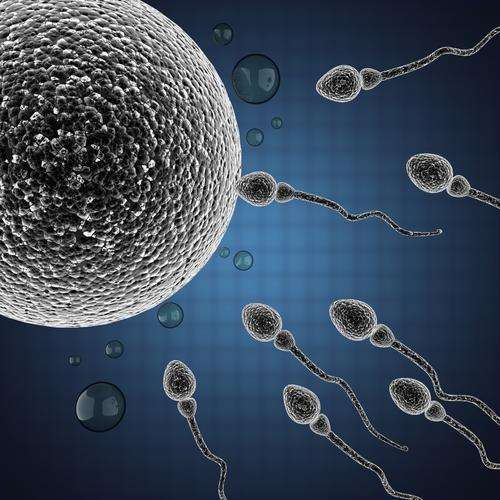Egg and Sperm Cells Made From Adult Cells
 For the first time, scientists have made human sperm and egg precursor cells from human adult skin cells. The work, detailed in a recent Cell paper, could ultimately change the age at which women stop having children.
For the first time, scientists have made human sperm and egg precursor cells from human adult skin cells. The work, detailed in a recent Cell paper, could ultimately change the age at which women stop having children.
"This paper represents another step forward in a very important area of stem cell biology," Renee Riejo Pera, a leading developmental biologist with Montana State University, told Bioscience Technology. Pera was uninvolved in the research. "The paper uncovers fundamentals in producing the earliest stage germ cells. Studies such as this help tremendously towards a goal of helping infertile men and women."
“The feedback has been extremely positive,” the Weizmann Institute’s Jacob Hanna, one of two senior authors on the paper, told Bioscience Technology. “I think this is a major leap forward."
Built on Kyoto University research
The work is built on research done by the Kyoto University lab of stem cell researcher Mitinori Saitou. In 2012, Saitou’s team reported in Science creating mouse pups from oocytes created by turning back the clock on adult skin cells. In 2011, Saitou did the same using sperm created from adult skin cells.
He could not fully create mature sperm and egg cells in a dish. Rather, after turning them backwards into the induced pluripotent stem (iPS) cell stage, he differentiated them into rudimentary egg and sperm cells, then placed them into mouse testes and ovaries which did the rest of the job.
The human cells
In the recent Cell paper, researchers led by Hanna and Azim Surani of the University of Cambridge reported they had replicated the in vitro part of Saitou’s mouse work.
Other groups have found the transition from mouse to human cells difficult. One reason: standard mouse embryonic stem (ES) and iPS cells are ‘naïve,’ unlike standard human ES and iPS cells, more responsive to attempts to differentiate into any number of mature cells.
But Hanna had created some of the first naïve human ES cells in a Nature study published in 2013. When his team tried Saitou’s recipe on Hanna’s naïve human female and male ES and iPS cells, it worked, and well. The teams were able to make precursor cells of human oocytes and sperm with 25 to 40 percent efficiency.
The cells share many qualities with natural human primordial germ cells. Their ‘epigenetic’ pattern—the placement of chemicals outside of DNA that turn genes on and off—was similar, for example. Also similar were protein markers.
“Naive cells have differences in gene expression, but also in their epigenome, which is probably more important,” Hanna told Bioscience Technology. “For example, H3K27me3, a repressive chromatin mark, is depleted over developmental regulators in naive conditions. We suspect this is key for the success of our protocol.”
One key difference between the mouse and human work: in human cells, a protein called SOX17 performed critical tasks that in mice are performed by SOX2. “It will be interesting to test in the future a variety of conditions and understand which ones are competent and which are not, and then try to correlate that with molecular signatures,” Hanna said.
But the end result was a great likeness between natural human primordial germ cells (PGCs) and the new manmade cells. “They are highly similar to early migrating PGCs that are formed during normal human development,” Hanna said.
More testing needed
The Cell teams stopped short of placing the rudimentary human eggs and sperm they’d created into human testes or ovaries, as Saitou had done. More testing is needed. The groups want to transplant the cells into non-human primates first. “If I had good access to a primate facility, I would have started doing that immediately,” Hanna said. “Unfortunately I am limited on that front in terms of resources--of course, after getting all ethical approvals necessary.”
Hanna said the teams are now, among other things, making egg cells from male human adult cells and sperm cells from female human adult cells. The groups are also following Saitou’s progress as he works on creating fully mature egg and sperm cells in the dish.
In the U.S., federal law still forbids federal funding for the creation of human embryos for research. Such laws may need to be reversed --or at least debated --if the process were to be tried here.
But the bottom line is that the teams are pleased.
“The efficiency and quality [of his PGCs] are equivalent to those obtained by Saitou in mice,” Hanna concluded to Bioscience Technology. “I was not surprised in a way. I was confident that the failure with conventional iPSCs would be resolved by toggling them back towards an alternative more naive state. But, of course, it was nice to see that my prediction was true.”
Early days
It is early days. Jeanne Loring, director of the Scripps Institute Center for Regenerative Medicine, tried to use the Hanna lab's recipe for making naive cells. She is interested in making sperm and egg cells for endangered rhinos, among other things. As noted, the Hanna paper indicated that naive cells were critical.
One of her post docs tried the Hanna protocol, then modified versions of it, "but he couldn't get anything to work," she said.
That doesn't mean the approach doesn't work, she said. But her lab is now waiting for other labs to repeat it before she tackles it again. "I'm sure many labs are jumping all over this," she said. "It's exciting. I don't see why it shouldn't be possible at this phase."
"Infertility affects so many couples and often there is no solution," Reijo Pera concluded. "This work sets the stage for studies that will help us understand oogenesis."

